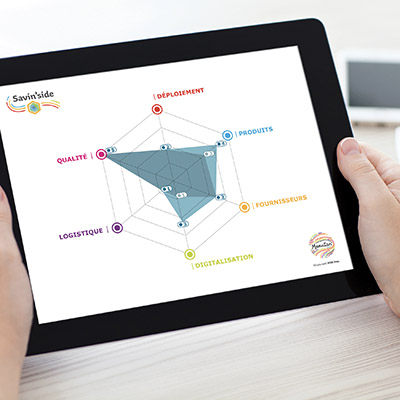In an environment as uncertain and volatile as ours, the digitalisation of procurement processes and financial processes has become an essential step for businesses. This is particularly true for accounts payable processes, which play a key role in working capital management. That’s why many organisations are implementing AP automation software. And for good reason - these tools prove to be tremendous levers for reducing errors, improving traceability and making savings.
What is AP automation?
AP automation (Accounts Payable Automation) consists of digitalising and automating supplier invoice processing from end to end. This ranges from capturing invoice data to paying suppliers. The company equips itself with digital technologies and automation solutions to replace manual systems. These are primarily tools such as optical character recognition (OCR), electronic data interchange (EDI) and machine learning.
This approach allows companies to optimise all processes related to receiving, processing and paying invoices sent by their suppliers. This paves the way for fluid, efficient and controlled management of invoices and payments. As a result, businesses improve overall efficiency and compliance, while optimising working capital.
AP automation: How does it work?
AP automation covers three main stages: From invoice receipt to payment processing and archiving.[NE1]
Invoice receipt
First, the company receives invoices electronically (EDI, PDF, supplier portal…) or on paper. When they are in paper format, they need to be converted to an electronic format. They are then scanned and processed, generally using OCR to extract and store the data.
Invoice matching and workflow
Once the data is captured, invoices are matched with purchase orders and delivery notes. They are then routed to the designated employee(s) for verification and validation. Then, they continue their journey to the company’s ERP (Enterprise Resource Planning) or accounting system for payment.
Invoice archiving
Lastly, all invoices are archived securely and compliantly. Electronic archiving makes it easy to search and retrieve each invoice. Additionally, audit trails allow tracking of all actions taken on invoices for financial control purposes.
What are the benefits of AP automation?
AP automation offers many benefits, from accelerating processes to informed decision-making.
Time savings
AP automation allows invoices to be processed quickly and efficiently. It eliminates various manual tasks, such as invoice entry and sending, which considerably streamlines the entire process. According to Generix Group, companies can accelerate invoice processing by around 80% thanks to accounts payable automation technologies[1]. This promotes compliance with payment deadlines, which helps strengthen supplier relationships.
Cost savings
AP automation also helps reduce invoice processing costs. This includes labour costs, as well as storage, postage and invoice production costs. According to Generix Group, companies can achieve savings of up to €10 per document1.
Better quality and compliance
AP automation allows businesses to eliminate potential human errors. There are no data entry discrepancies, double payments, potential fraud… This guarantees accuracy, as well as compliance with internal policies and regulations. Compliance rules are also integrated into the system. The process is entirely transparent, making it possible to track and prevent any associated risks.
Increased visibility and control
Lastly, this technology gives companies real-time visibility of their AP processes and their expenditure. This allows teams to better control cash flow, track payment deadlines more easily and ultimately make informed decisions. Oliver Piccard, Vice President of Global Financial Operations at Ritchie Brothers[2], supports this view: "It’s early days but we’ve quickly been able to achieve 65% end to end ‘touchless’ automatic matching in North America. This significantly reduces paper processing and enhances our internal controls over a large portion of our spend."
The future of AP automation
Today, AP automation has bright prospects ahead. This automation solution is synonymous with efficient cash flow management and payment deadline management. Two essential points for maintaining the liquidity, profitability and competitiveness of companies. Especially as this is taking place in a context of widespread adoption of electronic invoicing (e-invoicing).
Similarly, the rapid development of artificial intelligence (AI) and Machine Learning (ML) promises new advances. This new era marks a profound transformation, from accounts payable automation (AP automation) as we know it today to the emergence of autonomous systems.
This is highlighted by Kevin Permenter, Research Director at IDC[3]: "Where automation dictates that a certain set of actions happens when the trigger event occurs, autonomous, through AI/ML, dictates that the right set of actions happens when triggered, even when the underlying details shift. It is a subtle but powerful difference. Consider how an autonomous system allows approvals to flow to the appropriate person even when certain aspects of the approval flow shift and change due to absence, job changes, project team movement, and so forth — all without human intervention. In short, autonomy allows for the right actions to happen even amid uncertainty and change."
Lastly, many other trends are emerging in the world of AP automation, such as the adoption of cloud-based solutions for greater flexibility and accessibility. Or the rise of partnerships and technologies that enable ever faster payments (SWIFT GPI, SEP instant payment, ACH payments…).
As you can understand, accounts payable software plays the role of a control tower in managing organisations’ expenditure. And AP automation appears as a key tool for maintaining their cash flow and financial health. By reducing errors, improving financial visibility and accelerating processing, it helps strengthen business performance and competitiveness.
[2] Oliver, PICCARD (Vice President of Global Financial Operations, Ritchie Brothers), Basware [https://www.basware.com/en/why-basware/customers/ritchie-brothers/]
[3] Kevin, PERMENTER (Research Director, IDC), April 2023, Medius, [https://www.medius.com/media/tq4lm4wv/idc_accounts-payable-moving-from-automated-to-autonomous-whitepaper_april-2023.pdf]









